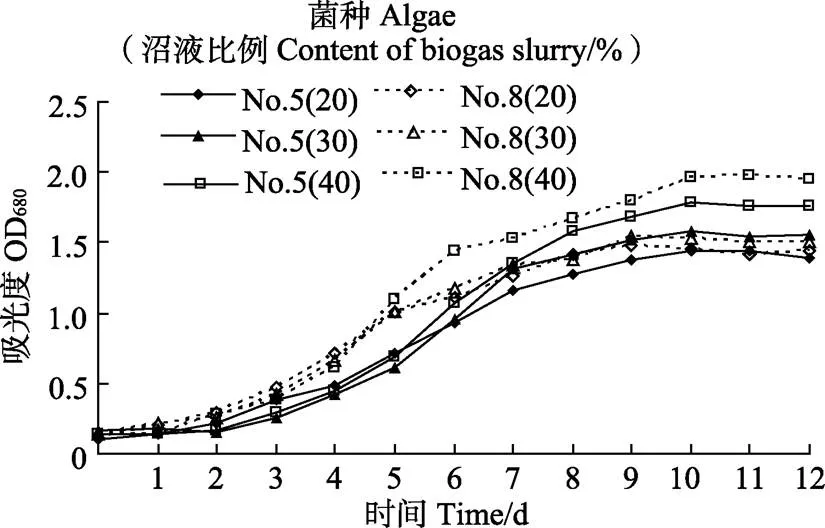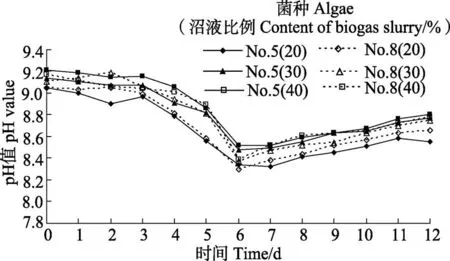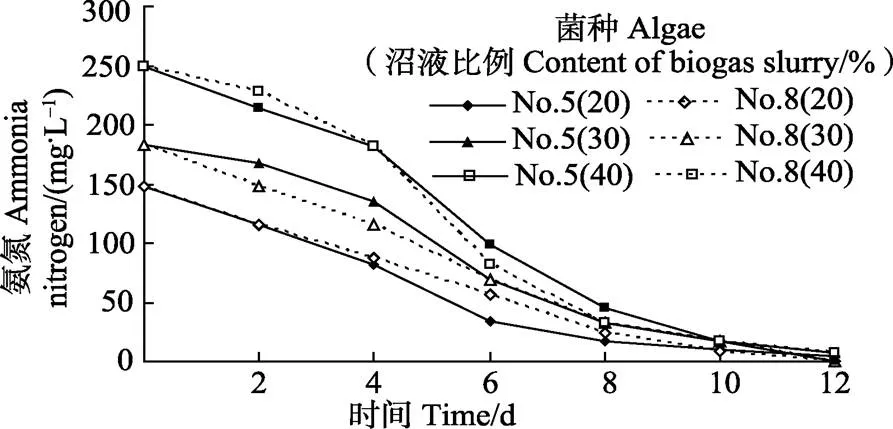小球藻对不同沼液添加量培养液的适应性及净化效果
2017-03-04王忠江王泽宇王丽丽
王忠江,隋 超,王泽宇,王丽丽,张 琪,吴 婧,李 岩
小球藻对不同沼液添加量培养液的适应性及净化效果
王忠江1,隋 超1,王泽宇1,王丽丽1,张 琪2,吴 婧1,李 岩1
(1. 东北农业大学工程学院,哈尔滨 150030;2. 中国科学院水生生物研究所,武汉 430072)
以成分相对简单、未经灭菌的秸秆厌氧发酵后沼液和BG11培养基的混合液为培养液,以FACHB-5号和FACHB-8号小球藻为藻种,利用人工气候培养箱,在微藻培养温度为(26±1)℃,光照强度为4 000 lx,24 h连续光照,通气量为1.5 L/min,沼液添加比例为20%、30%和40%的条件下,系统研究秸秆厌氧发酵后沼液直接用于微藻养殖对微藻系统的影响。结果表明:试验采用的小球藻FACHB-8号藻种和FACHB-5号藻种均能较好地适应化学需氧量COD含量相对较高的秸秆厌氧发酵后沼液,但FACHB-8号藻种与FACHB-5号藻种相比对沼液的适应时间更短,适应能力更强;FACHB-8号藻种和FACHB-5号藻种均能较好的利用和转化沼液中的有机污染物,各试验组的COD去除率均大于90%,总氮去除率均大于96%,总磷去除率均大于92%。该研究可为沼液直接用于微藻养殖提供参考。
秸秆;氮;磷;微藻;沼液;生长速率;化学需氧量
0 引 言
微藻生物质与其他陆生生物质资源相比,具有光合作用效率高、生长速度快、不占耕地、产品附加值高等优点[1-3],近年来得到各国学者的关注,成为争相研究的热点。但微藻养殖过程需要向培养液中添加大量的N、P等营养成分[4-5],极大地增加了微藻养殖的成本,成为制约微藻养殖产业发展的瓶颈。与此同时近年来大中型沼气工程在中国得到了迅速推广,而且这些沼气工程基本都是采用湿式厌氧发酵工艺,沼气工程在产生新能源沼气的同时也产生了大量的沼液废水[6-7],而这些沼液富含浓度较高的有机物,N、P等营养成分,以及种类繁多的微生物等[8-9],如果处置不当将对环境造成潜在威胁,因此如何拓宽沼液的利用途径及利用量引起越来越多人的关注。如果将沼气厌氧发酵后富含N、P等营养成分的沼液作为微藻养殖的营养液不但可以在一定程度上解决沼液的处置问题[10-11],同时还可以降低微藻养殖过程中补充氮源和磷源的成本[12-13]。但微藻在养殖过程中容易受到杂菌污染[14-15],而沼气发酵的原料种类众多,不同发酵原料沼气发酵后的沼液成分差别较大,如猪等畜禽的食物及消化道内存在的大量病原微生物在畜禽粪便中大量残留,此外由于目前规模化养殖场中各种化学添加剂的滥用,也使相对较多的重金属残留在畜禽粪便中,以这些畜禽废弃物为原料进行沼气发酵产生的沼液中存在大量的病原微生物等杂菌及重金属,成分复杂,容易对微藻产生污染[16-17],所以在前期研究中很多学者[18-19]均是将沼液灭菌后再进行微藻的养殖试验,进而增加了微藻养殖成本,影响微藻养殖产业的后续应用和推广。因此本试验针对以上问题,以成分相对简单的秸秆厌氧发酵后的沼液为原料,在不灭菌的条件下,通过改变秸秆沼液不同添加比例来系统研究不灭菌秸秆沼液对微藻养殖的影响规律。
1 材料与方法
1.1 材料
1.1.1 沼液及预处理
试验采用的沼液取自东北农业大学生物质能源实验室,沼气发酵的原料为稻秆,发酵时间为30 d,沼液的初始化学需氧量(chemical oxygen demand,COD)为21 015.28 mg/L、挥发性脂肪酸(volatile fatty acid,VFA)为937 mg/L、pH值为9.2、总氮质量浓度为803.53 mg/L、总磷质量浓度为62.74 mg/L、氨氮质量浓度为689.90、浊度为2374 NTU。沼气发酵后的剩余物经孔径0.075 mm尼龙标准筛去除大颗粒物,再经10 000 r/min去除小颗粒物获得本试验所用沼液,之后储存于4 ℃冰箱内备用,沼液的氨氮质量浓度为621.71 mg/L、总氮质量浓度为741.72 mg/L、总磷质量浓度为59.77 mg/L、化学需氧量(COD)为18 626.92 mg/L。
1.1.2 藻种
试验所用的藻种为蛋白核小球藻()与普通小球藻(),均由中国科学院水生生物研究所提供,藻种编号为FACHB-5(5号藻种)和FACHB-8(8号藻种)。
1.2 试验方法及条件
藻种采用沼液和BG11培养基的混合液进行培养,BG11培养基的配方见文献[20],沼液的添加比例分别为20%、30%和40%,试验采用的药品均为分析纯。利用人工气候培养箱(OBY-Q600-SEI,常州欧邦电子有限公司)进行微藻培养,培养温度为(26±1)℃,光照强度为4 000 lx,24 h连续光照,同时利用旋涡式气泵(HG-180,台湾亚士霸电机集团有限公司)向微藻培养液通入空气,通气量为1.5 L/min,空气在进入培养液前经0.2m滤膜过滤。
试验容器为1 000 mL三角瓶,内装600 mL培养液,在未调节pH值条件下将对数期藻种各100 mL分别加入各组培养液中,每组2个重复,进行批式培养,培养周期为12 d,每天取样测OD680、pH值,每隔1 d取样,在10 000 r/min条件下离心,测定上清液中氨氮、总氮、总磷和COD。
1.3 成分指标测定
生物量测定采用光密度法[21]。光密度法:取小球藻藻液,用紫外可见分光光度计(型号T6新世纪北京普析通用仪器有限责任公司)测定其在680 nm吸收波长下的光密度OD680,以此衡量小球藻在培养过程中的相对生长量。原料沼液的浊度采用分光光度法测定680 nm下的吸光值[22-23],培养液的COD测定采用重铬酸盐法,参照GB11914-1989《水质化学需氧量的测定重铬酸盐法》[24];总氮和氨氮采用凯式定氮法(Kjeldahl method)测定[25],所用仪器为全自动凯式定氮仪(KjeltecTM2300 FOSS丹麦),总磷测定采用钼酸铵分光光度法,参照GB11893- 1989《水质总磷的测定钼酸铵分光光度法》[26]。采用Excel2003进行数据处理;采用Design-Expert 8.0进行差异显著性分析。
2 结果与分析
2.1 微藻生长状况
图1为2种藻种在不同沼液添加比例下的生长曲线,从上图可以看出,当沼液添加比例在20%~40%范围内5号藻种和8号藻种均未出现明显的抑制作用,而且6个试验组的整体变化趋势一致,即试验前期(前2天)小幅上升,第2天5号藻种与8号藻种(在沼液添加量为20%、30%和40%时)之间均无显著性差异。之后(2~ 7 d)开始快速上升,第6天,5号藻种与8号藻种在沼液添加量为20%时无显著性差异;沼液添加量为30%时的差异达到显著水平(<0.05);添加量为40%时的差异达到极显著性水平(<0.01),后期逐渐趋于稳定,第11天,5号藻种与8号藻种在沼液添加量为20%与30%时无显著性差异;沼液添加量为40%时的差异达到显著水平(<0.05),试验结束时各试验组培养液的OD680值已经由试验开始时的0.1~0.2上升到1.4~2.0,这说明添加沼液未对5号藻种和8号藻种产生明显的抑制。从图中还可以看出,前6天8号藻种的OD680值均高于5号藻种,说明8号藻种对沼液的适应期较短,可以在较短的时间内迅速适应添加沼液的生长环境。此外从图1中还可以看出,添加沼液比例较小时,进入稳定期后,5号藻种和8号藻种的OD680值差别较小,而当沼液添加比例较大时,8号藻种的OD680值始终高于5号藻种,这说明在本试验条件下8号藻种与5号藻种相比对高浓度沼液的适应能力更强。

图1 微藻的生长曲线
2.2 pH值
图2为两种藻种在不同沼液添加比例溶液pH值的变化情况,从图2可以看出,6个试验组的pH值变化规律基本一致,即试验前期(前3天)小幅下降,第2天,5号藻种与8号藻种在沼液添加量为20%时的差异达到显著性水平(<0.05);添加量为30%时无显著性差异;添加量为40%时的差异达到显著性水平(<0.05),之后(3~6 d)开始快速下降,第6天5号藻种与8号藻种(在沼液添加量为20%、30%和40%时)之间均无显著性差异。第6天时培养液的pH值已经由试验开始时的9.0~9.2下降到8.3~8.5。后期又开始逐渐上升,第11天5号藻种与8号藻种(在沼液添加量为20%、30%和40%时)之间均无显著性差异。试验结束时各组培养液的pH值已经回升到8.6~8.8。这与各试验组的OD680值变化规律相对应,这是因为藻类在培养液中存在多种形态氮时,优先利用氨态氮[27],而藻细胞利用氨分子,使得培养液中H+浓度增加,pH值在微藻培养的前期出现下降,之后随着氨态氮含量降低,微藻开始利用培养液中的硝态氮,同时沼液中有机酸彻底降解,培养液的pH值开始逐渐上升[20]。
2.3 总氮
图3为2种藻种在不同沼液添加比例环境下溶液中总氮的变化情况,从图3可以看出,6个试验组的总氮变化规律基本一致,即试验前期(前2天)小幅下降,第2天5号藻种与8号藻种在沼液添加量为20%与40%时均无显著性差异;沼液添加量为30%时的差异达到极显著性水平(<0.01),之后(2~10 d)开始快速下降,第6天5号藻种与8号藻种(在沼液添加量为20%、30%和40%时)之间差异均达到极显著水平(<0.01)。后期逐渐趋于稳定,第11天5号藻种与8号藻种(在沼液添加量为20%、30%和40%时)之间均无显著性差异。试验结束时沼液添加量20%组、30%组和40%组的培养液中总氮含量由试验开始时的180、215和297 mg/L下降到6、8和12 mg/L,降幅分别达到97%、96%和96%,这说明利用沼液养殖微藻可以取得非常好的去除沼液中氮素的效果,充分实现沼液的资源化和无害化。从图3中还可以看出当沼液添加比例为较低的20%时,5号藻种和8号藻种2组在整个试验过程中总氮的差别非常小,而当培养液中沼液添加比例增加到30%和40%时,8号藻种培养液中总氮的含量在试验过程的大部分时间内均低于对应的5号藻种,而且在试验前期8号藻种的培养液中的总氮含量下降速度明显快于5号藻种,这与图1中的OD680值的变化规律相对应。

图2 pH值的变化

图3 总氮的变化
2.4 氨氮
图4为2种藻种在不同沼液添加比例环境下溶液中氨氮的变化情况,从图4可以看出,6个试验组的氨氮变化规律基本一致,即试验前期(前10天)始终处于下降趋势,之后开始逐渐趋于稳定,整体变化规律与总氮基本一致,试验结束时各试验组培养液的氨氮含量由开始时的148~249 mg/L下降到0~7 mg/L,期间第2天,5号藻种与8号藻种在沼液添加量为20%与30%时均无显著性差异;沼液添加量为40%时的差异达到显著性水平(<0.05),第6天,5号藻种与8号藻种在沼液添加量为30%时无显著性差异;沼液添加量为20%和40%时的差异均达到显著性水平(<0.05),第11天5号藻种与8号藻种(在沼液添加量为20%、30%和40%时)之间的差异均达到极显著水平(<0.01)。这主要是因为沼液中氮的主要存在形式为氨态氮,且微藻优先利用的也是氨态氮。
2.5 总磷
图5为2种藻种在不同沼液添加比例环境下溶液中总磷的变化情况,从图5可以看出,6个试验组的总磷变化规律基本一致,即试验前期(前4天)小幅下降,第2天5号藻种与8号藻种(在沼液添加量为20%、30%和40%时)之间均无显著性差异。之后(4~10 d)开始快速下降,第6天5号藻种与8号藻种(在沼液添加量为20%、30%和40%时)之间均无显著性差异。后期开始逐渐趋于稳定,第11天5号藻种与8号藻种在沼液添加量为20%时无显著性差异;沼液添加量为30%和40%时的差异均达到显著性水平(<0.05),试验结束时沼液添加量20%组、30%组和40%组的培养液中总磷含量由试验开始时的14、19和24 mg/L下降到2 mg/L以下,降幅均达到92%以上,这说明利用沼液养殖微藻也可以较好的去除沼液中的磷素。从图5中还可以看出当沼液添加比例为较低的20%和30%时,5号藻种和8号藻种两组在整个试验过程中总磷的差别很小,而当培养液中沼液添加比例增加到40%时,8号藻种培养液中总磷的含量从试验第4天开始中后期均低于对应的5号藻种,并一直维持到试验结束,这说明8号藻种更适合高浓度的沼液环境,对总磷的消耗速度更快。

图4 氨氮的变化
2.6 COD
本试验使用的沼液为稻杆厌氧发酵后沼液,稻杆沼气发酵时的TS浓度为10%(这个浓度在湿法发酵中是比较高的),沼气发酵时间为30 d(发酵时间主要是参照目前以秸秆为原料的大型沼气工程常采用的物料发酵时间),停止沼气发酵时发酵系统仍有沼气产生,说明仍有有机物未被降解和利用,但考虑到微藻产业化养殖以后采用的沼液必须适应大型沼气工程排出沼液的相关特性,同时也是要探讨COD值较高的沼液对微藻养殖的影响情况,所以在沼气发酵30 d后即停止了沼气发酵过程,并收集发酵后沼液作为后续微藻养殖的氮磷营养源。
图6为2种藻种在不同沼液添加比例溶液COD的变化情况,从图6可以看出,6个试验组的COD变化规律基本一致,即试验前期(前4天)小幅下降,第2天5号藻种与8号藻种(在沼液添加量为20%、30%和40%时)之间均无显著性差异。之后(4~8 d)开始快速下降,第6天5号藻种与8号藻种(在沼液添加量为20%、30%和40%时)之间均无显著性差异。后期逐渐趋于稳定,第11天5号藻种与8号藻种(在沼液添加量为20%、30%和40%时)之间均无显著性差异。试验结束时沼液添加量20%组、30%组和40%组的培养液中COD含量由试验开始时的4 500、6 993和9 336 mg/L下降到160、400和540 mg/L,降幅分别达到96%、94%和94%。COD含量的下降一方面是由于微藻代谢过程可以较好地利用和转化培养液中的氮磷等有机污染物[28],使培养液的COD含量下降;另一方面是由于微藻养殖过程中通入的空气中含有氧气,这些氧气提高了沼液中带入的好氧和兼氧微生物以及空气中的好氧微生物的活性,加速了培养液中有机物的降解,也导致了COD含量的下降。所以上述2个过程的共同作用才使培养液中COD含量出现了大幅下降。

图6 COD的变化
3 结 论
1)本试验采用的FACHB-8藻种和FACHB-5藻种均能较好地适应成分相对简单,化学需氧量COD含量相对较高的未经灭菌的秸秆厌氧发酵后沼液,但FACHB-8藻种与FACHB- 5藻种相比对沼液的适应时间更短,适应能力更强。
2)FACHB-8藻种和FACHB-5藻种均能较好的利用和转化沼液中的有机污染物,在培养温度为(26±1)℃,光照强度为4 000 lx,24 h连续光照,通气量为1.5 L/min的试验条件下培养12 d后,各试验组溶液中的COD去除率均大于90%,总氮去除率均大于96%,总磷去除率均大于92%。
[1] 侯坚,张培栋,袁宪正,等. 基于开放式培养的微藻生物柴油生命周期环境影响评价[J]. 农业工程学报,2011,27(7):251-257. Hou Jian, Zhang Peidong, Yuan Xianzheng, et al. Life cycle environmental impact assessment of biodiesel from microalgae in open ponds[J]. Transactions of the Chinese Society of Agricultural Engineering (Transactions of the CSAE), 2011, 27(7): 251-257. (in Chinese with English abstract)
[2] Gustavo B Leite, Ahmed E M. Abdelaziz, Patrick C. Hallenbeck. Algal biofuels: Challenges and opportunities[J]. Bioresource Technology, 2013, 145: 134-141.
[3] Chiu Shengyi, Kao Chienya, Chen Tsaiyu, et al. Cultivation of microalgal Chlorella for biomass and lipid production using wastewater as nutrient resource[J]. Bioresource Technology, 2015, 184: 179-189.
[4] Logan Christenson, Ronald Sims. Production and harvesting of microalgae for wastewater treatment, biofuels, and bioproducts[J]. Biotechnology Advances, 2011, 29: 686-702.
[5] Racharaks Ratanachat, Ge Xumeng, Li Yebo. Cultivation of marine microalgae using shale gas flowback water and anaerobic digestion effluent as the cultivation medium[J]. Bioresource Technology, 2015, 191: 146-156.
[6] 陈玉成,杨志敏,陈庆华,等. 大中型沼气工程厌氧发酵液的后处置技术[J]. 中国沼气,2009,28(1):14-20. Chen Yucheng, Yang Zhimin, Chen Qinghua, et al. An overview on disposal of anaerobic digestate for large scale biogas engineering[J]. China Biogas, 2009, 28(1): 14-20. (in Chinese with English abstract)
[7] 李祎雯,曲英华,徐奕琳,等. 不同发酵原料沼液的养分含量及变化[J]. 中国沼气,2012,30(3):17-20,24. Li Yiwen, Qu Yinghua, Xu Yilin, et al. Change of nutrition contents of biogas slurry with different fermentation raw materials[J]. China Biogas, 2012, 30(3): 17-20, 24. (in Chinese with English abstract)
[8] 谢晶,陈理,庞昌乐,等. 山东省沼气工程发展调研报告[J]. 中国沼气,2012,30(4):41-44,47. Xie Jing, Chen Li, Pang Changle, et al. Investigation report of biogas development in shandong province[J]. China Biogas, 2012, 30(4): 41-44, 47. (in Chinese with English abstract)
[9] 李伟,吴树彪,Hamidou Bah,等. 沼气工程高效稳定运行技术现状及展望[J]. 农业机械学报,2015,46(7): 187-202.Li Wei, Wu Shubiao, Hamidou Bah, et al. Status analysis and development prospect of biogas engineering technology[J]. Transactions of the Chinese Society for Agricultural Machinery,2015, 46(7): 187-202. (in Chinese with English abstract)
[10] Cai Ting, Park Stephen Y, Racharaks Ratanachat, et al. Cultivation of Nannochloropsis salina using anaerobic digestion effluent as a nutrient source for biofuel production[J]. Applied Energy, 2013, 108: 486-492.
[11] Cai Ting, Ge Xumeng, Stephen Y Park, et al. Comparison of. PCC6803 and Nannochloropsis salina for lipid production using artificial seawater and nutrients from anaerobic digestion effluent[J]. Bioresource Technology, 2013, 144: 255-260.
[12] 黄英明,王伟良,李元广,等. 微藻能源技术开发和产业化的发展思路与策略[J]. 生物工程学报,2010,26(7): 907-913. Huang Yingming, Wang Weiliang, Li Yuanguang, et al. Strategies for research and development and commercial production of microalgae bioenergy[J]. Chinese Journal of Biotechnology, 2010, 26(7): 907-913. (in Chinese with English abstract)
[13] 李元广,谭天伟,黄英明. 微藻生物柴油产业化技术中的若干科学问题及其分析[J]. 中国基础科学·工业生物技术专刊,2009(5):64-70. Li Yuanguang, TanTianwei, Huang Yingming. Some scientific issues to be resolved in the process for producing biodiesel from microalgae[J]. China Basic Science, 2009(5): 64-70. (in Chinese with English abstract)
[14] Wang Hui, Zhang Wei, Chen Lin, et al. The contamination and control of biological pollutants in mass cultivation of microalgae[J]. Bioresource Technology, 2013, 128: 745-750.
[15] 杨祎,陈立文,陈必链,等. 微藻净化沼液产业化研究进展[J]. 中国沼气,2015,33(4):49-53. Yang Yi, Chen Liwen, Chen Bilian, et al. Application of microalgae purifying biogas slurry and industrialization[J]. China Biogas, 2015, 33(4): 49-53. (in Chinese with English abstract)
[16] 陈红,韩宏蕾,辛丽花.废水处理系统中微型生物群落变化与水质净化[J]. 环境科学与管理,2012,37(1):90-95. Chen Hong, Han Honglei, Xin Lihua. Change of microbiological community in sewage treatment system and water quality purification[J]. Environmental Science and Management, 2012, 37(1): 90-95. (in Chinese with English abstract)
[17] 巫小丹,刘伟,阮榕生,等. 不同预处理方法对沼液养殖微藻的影响[J]. 环境污染与防治,2014,36(1):9-12,18. Wu Xiaodan, Liu Wei, Ruan Rongsheng, et al. Impacts of different pretreatment methods on microalgae cultivation in biogas slurry[J]. Environmental Pollution&Control, 2014, 36(1): 9-12, 18. (in Chinese with English abstract)
[18] 王钦琪,李环,王翠,等. 沼液培养的普通小球藻对CO2的去除[J]. 应用与环境生物学报,2011,17(5):700-705. Wang Qinqi, Li Huan, Wang Cui, et al. Reduction of CO2by Chlorella vulgaris cultured in biogas slurry[J]. Chinese Journal of Applied and Environmental Biology, 2011, 17 (5): 700-705. (in Chinese with English abstract)
[19] 王翠,李环,韦萍. 沼液培养小球藻生产油脂的研究[J]. 环境工程学报,2010,4(8):1753-1758. Wang Cui, Li Huan, Wei Ping. Study on microbial oil production with Chlorella cultured in biogas slurry[J]. Chinese Journal of Environmental Engineering, 2010, 4(8): 1753-1758. (in Chinese with English abstract)
[20] 霍书豪,陈玉碧,刘宇鹏,等. 添加沼液的BG11营养液微藻培养试验[J]. 农业工程学报,2012,28(8):241-246. Huo Shuhao, Chen Yubi, Liu Yupeng, et al. Experiment on microalgae cultivation in BG11 nutrient solution adding biogas slurry[J]. Transactions of the Chinese Society of Agricultural Engineering (Transactions of the CSAE), 2012, 28(8): 241-246. (in Chinese with English abstract)
[21] 高浩峰,李环,韦萍. 半连续及连续培养小球藻减排沼液及CO2[J]. 生物加工过程,2012,10(4):16-20. Gao Haofeng, Li Huan, Wei Ping. Reduction of biogas slurry and CO2by Chlorella vulgaris in semi-continuous and continuous cultures[J]. Chinese Journal of Bioprocess Engineering, 2012, 10(4): 16-20. (in Chinese with English abstract)
[22] 董永全,邓安民,郭桦冰,等. 蒙脱土/聚丙烯酰胺杂化絮凝剂制备及絮凝性能研究[J]. 环境科学学报,2009,29(11):2385-2392. Dong Yongquan, Deng Anmin, Guo Huabing, et al. Preparation and flocculation performance of a polyacrylamide/montmorilonite hybrid flocculan[J]. Acta Scientiae Circumstantiae, 2009, 29(11): 2385-2392. (in Chinese with English abstract)
[23] 刘培,张建华,王柯,等. 沼液中悬浮物对乙醇发酵的影响及其絮凝处理的研究[J]. 环境科学学报,2014,34(6):1455-1463. Liu Pei, Zhang Jianhua, Wang Ke, et al. Effect of suspended solids in digestate on ethanol fermentation and flocculation treatment[J]. Acta Scientiae Circumstantiae, 2014, 34(6): 1455-1463. (in Chinese with English abstract)
[24] 国家环境保护总局,《水和废水监测分析方法》编委会.水和废水监测分析方法[M]. 中国环境科学出版社,2002.
[25] 王忠江,蔡康妮,王丽丽,等. 沼肥表施对土壤氮素动态分布及氨挥发的影响[J]. 农业机械学报,2014,45(7): 139-143. Wang Zhongjiang, Cai Kangni, Wang Lili, et al. Influence of surface application of biogas slurry on ammonia volatilization and dynamic distribution of soil nitrogen[J]. Transactions of the Chinese Society for Agricultural Machinery, 2014, 45(7): 139-143. (in Chinese with English abstract)
[26] 吕素娟,张维,彭小伟,等. 城市生活废水用于产油微藻培养[J]. 生物工程学报,2011,2(3):445-452. Lü Sujuan, Zhang Wei, Peng Xiaowei, et al. Cultivating an oleaginous microalgae with municipal wastewater[J]. Chinese Journal of Biotechnology, 2011, 2(3): 445-452. (in Chinese with English abstract)
[27] 李鑫,胡洪营,甘柯. 氮元素对贫营养型二形栅藻LX1生长及去除氮磷特性的影响研究[C]// 中国环境科学学会:2008年中国水环境污染控制与生态修复技术学术研讨会论文集,广州,2008,936-948. Li Xin, Hu Hongying, Gan Ke. Study on the influence of nitrogen on the growth and N, P removal properties of low-nutrient-demanding Scenedesmus dimorphus LXI[C]// Chinese Society for Environmental Sciences: Symposium for Pollution Control and Ecological Restoration Techniques of Water Environments in China, Guangzhou, 2008: 936-948. (in Chinese with English abstract)
[28] 李岩,周文广,张晓东,等. 微藻培养技术处理猪粪厌氧发酵废水效果[J]. 农业工程学报,2011,27(增刊1): 101-104. Li Yan, Zhou Wenguang, Zhang Xiaodong, et al. Effect of microalgae culture on treatment of wastewater from anaerobic digested swine manure [J]. Transactions of the Chinese Society of Agricultural Engineering (Transactions of the CSAE), 2011, 27(Supp.1): 101-104. (in Chinese with English abstract)
Adaptation ofto culture liquid with different biogas slurryadding proportion and its purified effect
Wang Zhongjiang1, Sui Chao1, Wang Zeyu1, Wang Lili1, Zhang qi2, Wu Jing1, Li Yan1
(1.150030,;2.430072,)
This study mainly focused on the following problems like the higher cost of adding nitrogen and phosphorus in chlorella culture; the delayed and ineffective use of biogas slurry containing rich nutrient elements just as nitrogen, phosphorus, and so on after anaerobic fermentation; the easily contaminated microalgae caused by undesired microbes in microalgae culture; the higher cost of microalgae culture due to the biogas slurry pretreatments like sterilization and so forth when biogas slurry was serving as the culture medium; etc. The culture medium was the mixture of BG11 medium and biogas slurry from straw by anaerobic fermentation for 30 days. The biogas slurry fermented from straw was non-sterilized and relatively simple in composition. The algae species FACHB-5 and FACHB-8 chlorella were used. An artificial climate incubator was also used, in which the temperature for microalgae culture was kept at (26±1)℃, the light intensity was 4 000 lx, the light time was 24 hours continuously, and the ventilation volume was 1.5 L/min. In the experiment, the total nitrogen at the beginning was 180, 215 and 297 mg/L respectively in the experimental medium groups. The addition content of biogas slurry was 20%, 30% and 40% separately; and the results showed that the total nitrogen content of culture liquid was reduced to 6, 8 and 12 mg/L with the different biogas slurry treatments (20%, 30% and 40%), respectively, and the removal rate of total nitrogen was more than 96%. The total phosphorus content at the beginning was 14, 19 and 24 mg/L respectively in the experimental medium groups with the addition of biogas slurry was 20%, 30% and 40%, separately; At the end of the experiment, they reduced to less than 2 mg/L, and the removal rate of total phosphorus was more than 92%. Chemical oxygen demand (COD) content at the beginning was 4 500, 6 993 and 9 366 mg/L respectively, in the experimental medium groups with the addition of biogas slurry was 20%, 30% and 40%, and at the end of the experiment they reduced to 160, 400 and 540 mg/L respectively, the removal rate of COD was more than 90%. The experimental results showed that both FACHB-5 and FACHB-8 algae species could well adapt to biogas slurry which was relatively high in COD content from straw by anaerobic fermentation, and could well make the use of and remove the organic pollutants from biogas slurry. Compared with FACHB-5 algae species, FACHB-8 algae species needed shorter time to adapt, and had stronger adaptability to biogas slurry. What’s more, there was a strong correlation between the degradation of organic pollutants and the growth of chlorella in every experimental medium group. The study may lay a theoretical foundation for the application of biogas slurry which will be directly used in microalgae culture, and may have the magnificent significance for large-scale microalgae culture.
straw; nitrogen; phosphorus; microalgae; biogas slurry; growth rate; chemical oxygen demand
10.11975/j.issn.1002-6819.2017.03.030
Q938
A
1002-6819(2017)-03-0221-06
2016-03-09
2016-12-28
国家高技术研究发展计划(2014AA022001);国家自然科学基金(51406032);教育部留学回国人员科研启动基金(20131792);黑龙江省博士后科研启动基金资助项目(LBH-Q10148)联合资助
王忠江,男(汉族),黑龙江哈尔滨人,教授,博士,2011年赴美国俄亥俄州立大学研修,主要从事农业生物环境与能源工程领域研究。 哈尔滨东北农业大学工程学院,150030,E-mail:neauwzj@126.com
王忠江,隋 超,王泽宇,王丽丽,张 琪,吴 婧,李 岩. 小球藻对不同沼液添加量培养液的适应性及净化效果[J]. 农业工程学报,2017,33(3):221-226. doi:10.11975/j.issn.1002-6819.2017.03.030 http://www.tcsae.org
Wang Zhongjiang, Sui Chao, Wang Zeyu, Wang Lili, Zhang qi, Wu Jing, Li Yan.Adaptation ofto culture liquid with different biogas slurryadding proportion and its purified effect[J]. Transactions of the Chinese Society of Agricultural Engineering (Transactions of the CSAE), 2017, 33(3): 221-226. (in Chinese with English abstract) doi:10.11975/j.issn.1002-6819.2017.03.030 http://www.tcsae.org
